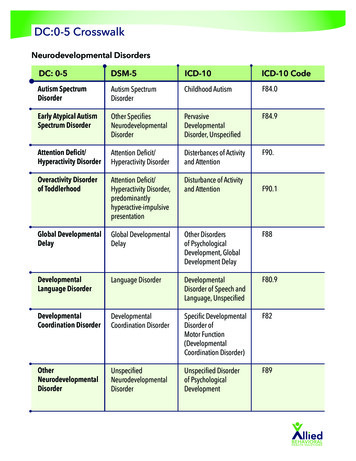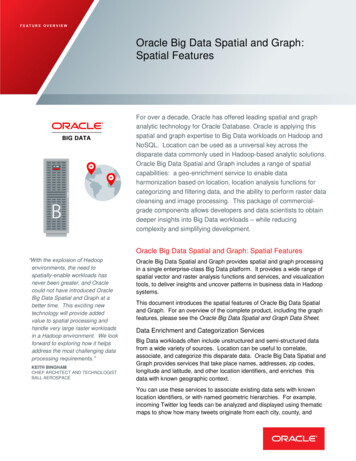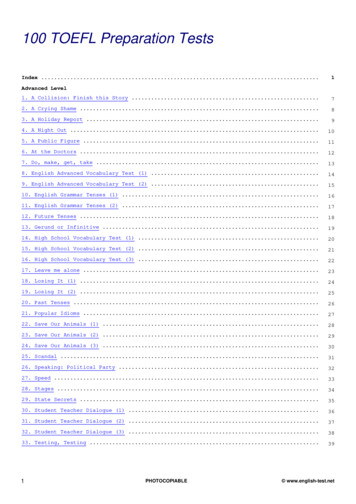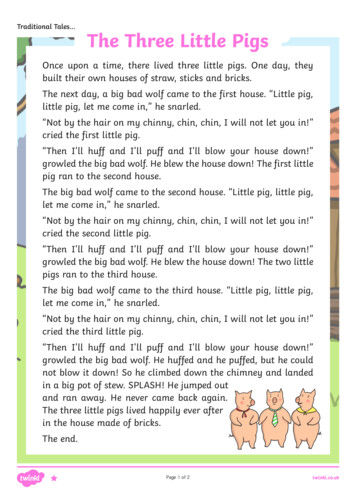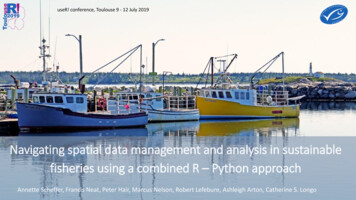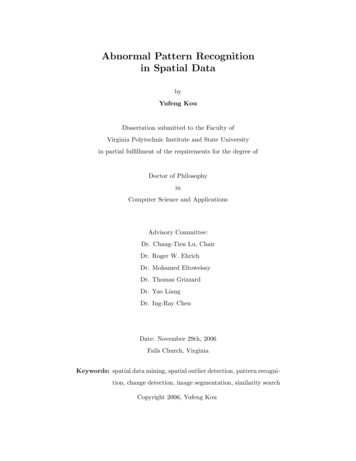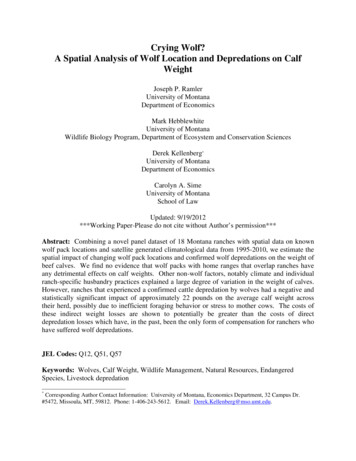
Transcription
Crying Wolf?A Spatial Analysis of Wolf Location and Depredations on CalfWeightJoseph P. RamlerUniversity of MontanaDepartment of EconomicsMark HebblewhiteUniversity of MontanaWildlife Biology Program, Department of Ecosystem and Conservation SciencesDerek Kellenberg*University of MontanaDepartment of EconomicsCarolyn A. SimeUniversity of MontanaSchool of LawUpdated: 9/19/2012***Working Paper-Please do not cite without Author’s permission***Abstract: Combining a novel panel dataset of 18 Montana ranches with spatial data on knownwolf pack locations and satellite generated climatological data from 1995-2010, we estimate thespatial impact of changing wolf pack locations and confirmed wolf depredations on the weight ofbeef calves. We find no evidence that wolf packs with home ranges that overlap ranches haveany detrimental effects on calf weights. Other non-wolf factors, notably climate and individualranch-specific husbandry practices explained a large degree of variation in the weight of calves.However, ranches that experienced a confirmed cattle depredation by wolves had a negative andstatistically significant impact of approximately 22 pounds on the average calf weight acrosstheir herd, possibly due to inefficient foraging behavior or stress to mother cows. The costs ofthese indirect weight losses are shown to potentially be greater than the costs of directdepredation losses which have, in the past, been the only form of compensation for ranchers whohave suffered wolf depredations.JEL Codes: Q12, Q51, Q57Keywords: Wolves, Calf Weight, Wildlife Management, Natural Resources, EndangeredSpecies, Livestock depredation*Corresponding Author Contact Information: University of Montana, Economics Department, 32 Campus Dr.#5472, Missoula, MT, 59812. Phone: 1-406-243-5612. Email: Derek.Kellenberg@mso.umt.edu.
I.INTRODUCTIONThe 1995 reintroduction of the gray wolf to Yellowstone National Park and northern Idahorekindled a decade’s long debate on the social benefits and costs of wolves on the naturallandscape. Proponents argue that wolves are being returned to their natural habitat and provideimportant ecological functions as a predator at the top of the food chain while opponents havecountered that wolves prey on game animals (such as elk, moose, and deer) and livestock that arecrucial to the livelihoods and way of life of many in the West. The 2009 delisting of the graywolf from the Endangered Species Act and subsequent court cases has only intensified an oftenemotionally charged public discourse.The total costs and benefits of wolves on the naturallandscape are varied and intricate, and typically accrue differentially to urban and ruraleconomies. In this paper, we do not seek to answer the question of whether the net social costsof wolves is positive or negative, but instead focus on one intriguing and understudiedcomponent of changing wolf locations: the effects of wolf location and wolf depredations on theweight of domestic calves.Historically, studies examining the impact of predators, such as wolves, on domesticlivestock have been conducted using direct depredation rates (Sommers, et al., 2010; Muhly andMusiani, 2009; Bradley & Pletscher, 2005; Bradley, et al., 2005; Breck & Meier, 2004; Oakleaf,Mack & Murray, 2003; Treves, et al., 2002; Stahl, et al., 2001). However, it has been suggestedthat predators may have impacts on livestock reaching beyond direct depredation (Kluever, et al.,2008; Howery & DeLiberto, 2004). One claim in particular is that wolves decrease the averageweight of calves (Alderman, 2006) by stressing mother cattle, increasing movement rates, orencouraging inefficient foraging behavior. To date, no studies have empirically estimated theindirect effects of wolves on calf weight. Is it the case that ranchers are simply ‘crying wolf’? or2
is there evidence that wolves have indirect effects on calf weight? To answer the question, wecombine a novel panel dataset on 18 ranches in Montana with satellite generated climatologicaland forage data with spatial data on known wolf packs to empirically estimate the reduced formimpact of wolf location and confirmed wolf depredations on calf weight.We do not findstatistically significant effects of wolf home range locations on calf weight for our sampleranches, suggesting that simply having wolf home ranges that overlap with cattle grazing areashas no effect on cattle behavior that would affect calf weights. However, we do find that whenthere is at least one confirmed cattle depredation by wolves on a ranch there is a negative andstatistically significant effect on calf weights. All else equal, calves that are pastured on a ranchwhere a confirmed wolf depredation occurs are 3.5%, or 22 pounds, lighter than calves pasturedon ranches without a confirmed wolf depredation. For the average ranch in our sample, thisweight loss translates into a 6,679 loss in revenue when calves are sold. Thus, while wolf homeranges that overlap calf pastures do not have any significant effects on calf weights, ranchers arenot simply ‘crying wolf’ on ranches where wolves kill cattle. We show that there are negativeimpacts on calf weights across the herd beyond the direct loss of depredation.In the next section we present some background on wolves, Montana cattle ranching, and thecompensation programs that have been in place over the past decade for ranchers who aredirectly affected by wolf predation. In Section III, we present the empirical model and the dataused in the analysis as well as the relationship between the model and the relevant literature. InSections IV and V we present the results of the analysis as well as a discussion of the economicimpacts of the results and in Section VI we conclude.II.BACKGROUND3
Gray wolves roamed freely and extensively throughout the mountains and grasslands ofwhat is present day Montana during the time of the Lewis & Clark Expedition from 1804 to1806(Young & Goldman, 1944). However, it wasn’t long after that cattleman began driving herds ofcattle up from Texas in search of pastureland for their stock (Power & Barrett, 2001, p. 51) andmuch of wolves’ natural prey, such as bison, elk, and deer were hunted to near extinction bywestern settlers. The loss of natural prey lead to wolves and other predatory species posing anincreasing depredation threat to the growing livestock industry and predators were subsequentlytargeted for eradication. Wolf bounty laws were enacted in 1884 to accelerate the process ofwolf eradication, and by 1936 self-sustaining wolf populations were said to be extinct inMontana (Riley, Nesslage & Maurer, 2004; Mech, 1970).This remained true until the late 1970’s, when wolves from Canada began to move southand naturally recolonize Glacier National Park (GNP) in northern Montana. During the 1980swolves slowly began to den and reproduce in GNP which represented the first signs of a residentwolf population in Montana since the 1930s (Ream, Fairchild, Boyd & Blakesley, 1989). Sincethen, the resident wolf population in northwestern Montana has increased naturally (Boyd et al.,1995; Ream, Fairchild, Boyd & Blakesley, 1989).In an effort to fully restore the gray wolf under the federal Endangered Species Act,Congress directed the United States Fish & Wildlife Service (USFWS) to facilitate recovery byactively reintroducing the gray wolf into other suitable areas of the US Northern Rockies such asYellowstone National Park (YNP) and central Idaho (USFWS, 1987). After reintroduction, wolfnumber and distribution steadily expanded beyond YNP, encompassing both public and privatelands. As a consequence, rural ranchers have seen an increase in wolf inhabitance on and around4
their lands. As of December 31, 2010 the Montana wolf population had grown to an estimatedminimum number of 566 wolves (Sime et al., 2011).The increased interaction between wolves and livestock in Montana has led todocumented effects on the state’s ranching industry. In 2010, the United States Department ofAgriculture: Wildlife Service (WS) confirmed that 87 cattle were killed by wolves statewide.However, many of Montana’s wolves routinely encounter, but do not kill, domestic livestock(Sime et al., 2007).COMPENSATION TO RANCHERS FOR WOLF DEPREDATION OF LIVESTOCKDirect injury or death of cattle due to wolves is the most evident negative effect wolveshave on cattle ranchers. Although domestic cattle aren’t natural prey for wolves, they havebecome a food target of wolf packs in the US due to their abundance and vulnerability (Harper,Paul & Mech, 2005). The potential for depredation of livestock was recognized by state andfederal agencies before wolves were reintroduced into YNP and central Idaho (Sime et al., 2011;USFWS, 1987). These depredations have resulted in monetary losses to individual rancherswhich have been addressed, at least partially, through economic compensation for lost livestock.For Montana ranchers to receive monetary compensation for losses due to wolves, thekilled or injured animal must be investigated by a WS agent. After investigating a case ofsuspected predation the WS agent will issue a report including their expert opinions on theincident. One of three possible conclusions will be submitted in the report: it is “confirmed1”1Confirmed is defined by USDA Wildlife Services to be: reasonable physical evidence that livestock was actuallyattacked or killed by a wolf, including but not limited to the presence of bite marks indicative of the spacing ofcanine tooth punctures of wolves and associated subcutaneous hemorrhaging and tissue damage indicating that theattack occurred while the animal was alive, feeding patterns on the carcass, fresh tracks, scat, hair rubbed off onfences or brush, eyewitness accounts, or other physical evidence that allows a reasonable inference of wolf predationon an animal that has been largely consumed (Montana State Legislature, 2009).5
that predators were the cause of the death or injury; it is “probable2” that the incident waspredator related; or there is inconclusive evidence to attribute the incident to predator activity.The investigating WS agent also determines the species of predator (i.e. wolf, bear, coyote,mountain lion, etc.) if it was an instance of predation.For ranchers to get monetarycompensation for their loss, the investigating agent must conclude that their loss was either a“confirmed” or “probable” wolf depredation incident. The available avenues of compensationfor Montana ranchers affected by wolf predation have changed over time.The first available compensation for Montana ranchers affected by wolf depredationscame in 1987 from The Defenders of Wildlife (DOW), a non-governmental environmentalorganization, who designated 100,000 to compensate American ranchers in the northern RockyMountains for livestock lost to confirmed wolf predation. In 1997 the compensation fund wasofficially named the Defenders of Wildlife Wolf Compensation Trust and the fund was doubledto 200,000 in 1999 (Background on Defenders of Wildlife Wolf Compensation Trust, 2011).DOW paid full value for a confirmed wolf depredation incident and 50% of the determined valueof the livestock for a probable wolf predation incident. Though the assessed value of the animalin question may have been higher, DOW capped compensation at 3,000 per lost animal(Frequently Asked Questions about the Wolf Compensation Trust, 2011).From 1987 through 2009, DOW issued 429,880 in compensation for wolf depredationsof livestock in Montana; included in this statistic is 100,000 given to Montana to help initiate astate-run compensation fund for ranchers who experience wolf predation (Wolf Compensation2Probable is defined by USDA Wildlife Services to be: the presence of some evidence to suggest possible predationbut a lack of sufficient evidence to clearly confirm predation by a particular species. A kill may be classified asprobable depending on factors including but not limited to recent confirmed predation by the suspected depredatingspecies in the same or nearby area, recent observation of the livestock by the owner or the owner’s employees, andtelemetry monitoring data, sightings, howling, or fresh tracks suggesting that the suspected depredating species mayhave been in the area when the depredation occurred (Montana State Legislature, 2009).6
Payment Statistics, n.d.). With Montana’s program underway following delisting of wolves in2009, DOW ceased directly compensating ranchers as of September 2010.In 2007 the Montana Legislature created the Montana Livestock Loss Reduction &Mitigation Board (LLRMB). The LLRMB currently acts as the sole means of reimbursement toMontana livestock producers for “confirmed” and “probable” livestock losses due to wolfdepredation. In 2011, the LLRMB issued just over 75,000 in compensation to ranchers forcattle losses due to wolf predation in Montana3.MONTANA CATTLE RANCHINGCattle ranches in Montana are predominately cow-calf operations. Mature female cowsare bred to bulls in the summer and give birth to calves in late winter or early spring of thefollowing year (Agriculture & Business, 2007). While calves are still nursing, the cow-calf pairsare let out to pasture land for the summer and early Fall to graze. Montana summer pasture forcattle is privately deeded or public land leased to a ranch by the United States Bureau of LandManagement (BLM) or the U.S. Forest Service which is referred to as a grazing allotment.Calves stay with the mother cows for about 6 months until they are weaned in the fall andthen generally sold as feeder calves4 (Hanawalt, 2011). Livestock producers typically have atarget in mind for what their calves should weigh at the time of weaning. Producers budget theirtime, finances, and other resources accordingly throughout the year based on those expectations.If, at the end of the grazing season, a herd of calves weighs less than expected, a rancher’s profitmargin is directly affected. Therefore, it is important to the economic sustainability of theoperation that calves maintain an optimal and expected trend in weight gain over the course ofthe grazing season.34http://liv.mt.gov/LLB/lossdata.mcpx.A feeder calf is a weaned calf sold to a feedlot where it will be fattened up for the purpose of beef production.7
To identify any potential indirect effects wolves may have on calf weight in westernMontana, it is imperative to understand what else may also affect pre-weaning calf weight trends.In the model and discussion below is a review of the literature about animal husbandry andenvironmental factors influencing calf weight, predator/prey interactions, and the potential linksbetween them.III.EMPIRICAL MODEL AND DATAOur empirical strategy employed a novel panel dataset containing calf-weaning weights for18 western Montana ranches from 1995 to 2010 and combines it with ranch specific husbandrypractices, environmental and climatological spatial data, and spatial data on known wolf packhome ranges and confirmed wolf killings of livestock. The dataset contained ranches that havebeen impacted by wolf presence and those that have not, which allowed us to estimate theaverage treatment effect of known wolf activity on calf weight using a quasi-experimental panellevel differences-in-differences approach. Prior research has used linear regression procedures toestimate the effects of calf sex (Barlow, Dettmann & Williams, 1978), genetic and environmentalfactors (Brown, Brown & Butts, 1972), and other covariates (Cundiff, Willham & Pratt, 1966and Dal Zotto, et al., 2009) on calf weight. The empirical model used in the analysis builds onthis prior calf weight research by regressing average calf weaning weight on ranch i in year t onall measurable ranch specific, environmental, and climatological covariates believed to have aninfluence on calf weight, but also includes a treatment effect for the time-variant spatial locationof known wolf-pack home ranges and confirmed kills of cattle by wolves. There are twoobservations, an average heifer (female calf) weight and average steer (male calf) weight, foreach ranch i in year t. The regression model is displayed in equation (1) below:8
1816calf weightit α i α t x it β w it η eiti 1t 1.(1)The coefficients, αi and αt, are ranch and year specific fixed effects. Cow-calf producershave heterogeneous geographic locations and idiosyncratic styles of husbandry practices that donot change over time but can lead to important differences in calf weight (MacGregor & Casey,2000; Brown, Brown & Butts, 1972). Ranch fixed effects are included to capture all unobservedranch specific characteristics (such as unobserved husbandry practices, ranch terraincharacteristics such as slope and elevation, or ranch geography) that do not change over time,while year fixed effects control for unobservable year specific effects that are common acrossranches (such as state or federal policies, changes in industry norms, feed quality, or the qualityof vaccination products). The vector, xit, includes ranch level husbandry practices andenvironmental characteristics that change by ranch and year, wit is the vector of treatmentmeasures of wolf presence on ranch i in year t, and eit is a normally distributed random errorterm.One of the primary challenges of the study was to identify a random selection of ranchers inwestern Montana that would be willing to share their proprietary ranching and production datafor their cow-calf operations.No single database of Montana cow-calf producers exists.However, we contacted several livestock industry associations and organizations which maintainmembership databases. Membership in these organizations does not imply that the member is acattle producer, as many of the organizations we worked with provide a variety of services andinformation related to agriculture and ranching and anyone interested in these issues is able tojoin. However, sampling from these organizations’ membership lists provided a more focusedpopulation to identify cow-calf producers in Montana. Working closely with several of these9
organizations5, 826 emails and letters were sent to a random selection of members of theseorganizations seeking participation along with a brief explanation of the study and the minimumparameters for participation6. Ranchers willing to participate in the study were able to enter theircontact information into a website (if contacted by email) or could fill out and mail in a preaddressed, postage paid, postcard (if contacted my mail). Once a rancher submitted their contactinformation, they were contacted with a follow up phone call to confirm their willingness toparticipate and able provide the necessary survey information. For those willing and able toprovide the necessary information, an on-ranch interview was scheduled.During the on-ranch interview, we collected ranch specific data such as ranch level yearlyaverage weaning weights for both steers and heifers and ranch specific husbandry practices. Inparticular, the survey was designed to document any ranch specific husbandry practices—such ascalf breed, calving dates, hormone programs, etc.— that may have changed over time that couldhave a direct influence on the weaning weight of the calves7. Of the 826 letters and emails sentout, 54 (6.54%) responded. Many respondents did not qualify for participation (e.g. did not raisefeeder calves, had not been ranching for a long enough period of time, did not have sufficientrecords of past calf weight, etc.) and therefore were not selected for on-ranch interviews. Of the54 respondents, 21 were selected for an on-ranch interview; 18 of which were used in this study8.5The organizations were the Montana Cattleman’s Association, the Montana Stockgrowers Association, CrazyMountain Stockgrowers Association, Gallatin Beef Producers, Park County Stockgrowers Association, MadisonJefferson County MSU Extension Office, Beaverhead County MSU Extension Office, and the Powell County MSUExtension Office.6Minimum parameters for participation were that the ranch had to be able to provide average calf weaning weightsfrom approximately 1995 to 2010 and that they have a minimum of 80 cow-calf pairs per year.7The data from the on-ranch survey was conducted and filled out by the surveyor, not the rancher.8Two of the 21 ranches that were selected for on-ranch interviews did not separate their steer and heifer calfweaning weights and therefore were not comparable to the other 18 ranches in the study that did separate weights forsteers and heifers so these 2 ranches were not included in the analysis. A third ranch ultimately ended up havingincomplete records and several missing years of data and was also not included in the analysis.10
In the sections that follow, we discuss the data collected in the on ranch survey, theclimatological data, wolf data, and the importance of each of the covariates collected in the studyfor explaining calf weight.TIME INVARIANT RANCH-SPECIFIC HUSBANDRY PRACTICESIn this section we first discuss several factors that are ranch specific and important forcalf weight, but do not change over time and are assumed to be captured by the ranch specificfixed effects in the empirical model.GEOGRAPHYInformation was gathered during on-ranch interviews about where sample calves werepastured during the summer and if that changed over the study period. None of the 18 ranches inthe sample changed pasture size or spatial location over the study’s time period. Combininginformation about the location of ranch herds during the summer with data from the MontanaCadastral Database9, spatial representations of calf summer pastures for each ranch were created.Summer pasture for the ranches in the sample consists of a combination of deeded, privately, andpublicly leased land.AGE OF MOTHER COWThe average age of the herd has been shown to affect the weight gained by pre-weanedcalves (Zalesky, LaShell & Selzer, 2007; Barlow, et al., 1978; Swiger, et al., 1962). Previous9Data was downloaded from ftp://ftp.gis.mt.gov/cadastralframework. The Cadastral Database is being continuallyupdated to account for changing land ownership status. The data used in this study are current through October 10,2010. See the Appendix: Figure 8 for a breakdown of when the county specific data used in this study were lastupdated.11
lactation status10 of mother cows has been shown to influence the average daily weight gain andweaning weight of calves (Beffa, van Wyk & Erasmus, 2009). Younger mother cows demandextra forage consumption for their own physical growth, which decreases milk productionnecessary for optimal calf growth (Hetzel, et al., 1989; Tawonezvi, 1989; Tawonezvi, Brownlee& Ward, 1986; Thorpe, Cruickshank & Thompson, 1980).The effect of age of the mother cow on weaning weight of calves has been intenselyresearched, but findings vary across studies due to differences in breeds, genetic selection, andexperimental practices. Weaning weights of calves increased with the increasing age of themother cow peaking for 8-10 year old dams (Beffa, van Wyk, & Erasmus, 2009) in one studyand 6-9 year old dams (Minyard & Dinkel, 1965) in another. Other researchers found themaximum production age of a cow to be between 6-10 years (Sawyer, Bogart & Oloufa, 1948;Rollins & Guilbert, 1954; Burgess, Landblom & Stonaker, 1954; Nelms & Bogart, 1956;McCormick, Southwell & Warwick, 1956). Barlow et al. (1978) found that weaning weights ofboth steer and heifer Angus calves increased as the dam aged to 4 years while weaning weightsfor both sexes remained fairly constant across the cow ages of 5-8 years, inferring the cow hadreached full maturity.The yearly replacement of old cows with younger cows with little or no previousmothering experience may impact the average calf weaning weight of a herd. Though we werenot able to quantifiably account for the age of mother cows in the sample ranch herds (mostranchers surveyed did not have these detailed records), personal interviews with the ranchersindicated that the yearly replacement rate of old cows with new, younger cows within a sampleranch herd remained fairly constant from year to year. To the extent the average age of the10This refers to whether or not a cow has reared a calf in the past. It is a measure of the physical experience of themother cow.12
mother cows on a ranch stayed constant over time, the effect of the mother cow’s age on calfweaning weights was captured by the ranch fixed effects.SUPPLEMENTAL FEEDINGSupplemental feeding practices positively influence weight gain and birth weights of beefcalves by increasing the fat intake of prenatal cows (Dietz, et al., 2003; Havstad, McInerney &Church, 1989). Pregnant cows fed rations of predominately high energy corn or dried distillersgrains birth heavier calves compared to cows gaining nourishment from grass hay (Radunz, etal., 2010).For cattle that demand high levels of energy to maintain productivity such aspregnant cows and growing calves, a high-protein supplement can boost digestion efficiencywhich contributes to increased milk production and weight gain (Rinehart, 2006).Otherresearchers concluded through a controlled experiment that feeding protein-rich foodsupplements to pregnant cows has no significant effect on calf weaning weight (Alderton, et al.,2000).Though feeding and grazing practices may vary across sample ranches, none of thesample ranchers changed their supplemental feeding regimens over the time period of the studyand thus, the variation in supplemental feeding practices and their potential effect on calf weightis assumed to be captured by the ranch fixed effects.TIME VARIANT RANCH HUSBANDRY PRACTICESIn this section we discuss several ranch-specific factors that are important for calf weightbut potentially change over time. These factors are not captured by the ranch specific fixedeffects in the empirical model.SEX OF CALF13
The sex of the calf has consistently been shown to have an effect on calf weight gain.Barlow et al. (1978) found that male Angus calves wean 16.58 kg heavier than their femalecounterparts, while castrated male calves (steers)11 have been shown to wean as much as 7%heavier than heifer calves (Beffa, van Wyk & Erasmus, 2009). Other researchers have foundsteers gain approximately 5% more weight than their female counterparts of the same age andbreed (Hanawalt, 2011). The dependent variable in the estimation model, calf weight, wascategorized by the sex of the calves represented. There are a total of 226 castrated male calf(steer), and 211 female calf (heifer) sample observations on calf weight12.CALF AGEThe age of a calf has been shown to be a significant factor in determining calf weight atweaning (Beffa, van Wyk & Erasmus, 2009). The effect of calf age (in days) on weaning weighthas been shown to be equal to as much as 1.46 pounds per day controlling for sex of the calf, ageof the mother cow, and year (Botkin & Whatley, 1953). Others have reported the effects of ageon weaning weight of 1.33 pounds (Koger & Knox, 1945) and 1.20 pounds (Minyard & Dinkel,1965) per day.This study used a calculated average age of calves (in days) on a ranch to account for theeffect of calf age on weaning weight. Calf age was measured as the number of days between theaverage median birth date and the weaning date of calves on ranch i in year t. The averagemedian birth date of calves was calculated using the approximate birth date of the first and lastcalf born for each ranch i in year t. Calving season can often last for 100 days or more, butresearch has shown that the distribution of calves born during calving season on a ranch isroughly normally distributed, centered on the middle of the calving season (Minyard & Dinkel,11Steers are male calves that have been castrated. A male calf that has not been castrated is referred to as a bull calf. There are slightly fewer heifer observations as there were a few ranches that only recorded their steer weightsfor some years.1214
1965). Using the average median birth dates and weaning (or sale) dates, an average age (indays) of calves on ranch i in year t was calculated. Calves in the sample ranged in average agefrom 160 to 347 days.CALF BREEDSeveral studies examining the effect of calf breeds on weaning weights have shown thatbreed is a determining factor in the growth and body weight of pre-weaned beef cattle (Wiltbank,et al., 1966; Gregory, et al., 1965; Brown, Brown & Butts, 1972), although Minyard & Dinkel[1965] found that differences in weaning weights between some breeds are insignificant.Biologists have shown that genetic selection using crossbreeding can influence weight gain andmaturation trends of calves (Dal Zotto, et al., 2009; MacNeil, 2003; Laster, Glimp & Gregory,1972). Birth weight and weaning weight have been shown to be affected by altering the geneticproportions of crossbred calves (Dadi, et al., 2002; Skrypzeck, et al., 2000).In addition,different breeds and crossbreeds yield varying conception and calving intervals which influencesbreeding and calving times (Doren, Long & Cartwright, 1986). This study incorporates dummyvariables for the breed (including cross-breeds) of calves on ranch i in year t to control for anypossible effects of breed on calf weight. Ten different breeds and crossbreeds of calves areobserved in this study with the most prevalent being Black Angus.HORMONE IMPLANTINGSome calf producers implant their calf herd with growth hormones to stimulate weightgain which has been shown to increase average daily weight by 20% (Burroughs, et al., 1954).Average daily weight gain of finishing steers13 has been shown to increase by 16% (Rumsey, etal., 1996) and as much as 23% (Kahl, Bitman & Rumsey, 1978) when implanted with a growth13Finishing steers are male castrated calves that have been weaned and are in the last few months of preparationbefore they are slaughtered for beef production.15
hormon
#5472, Missoula, MT, 59812. Phone: 1-406-243-5612. Email: Derek.Kellenberg@mso.umt.edu . 2 I. . encompassing both public and private lands. As a consequence, rural ranchers have seen an increase in wolf inhabitance on and around . came in 1987 from The Defenders of Wildlife (DOW), a non-governmental environmental .
